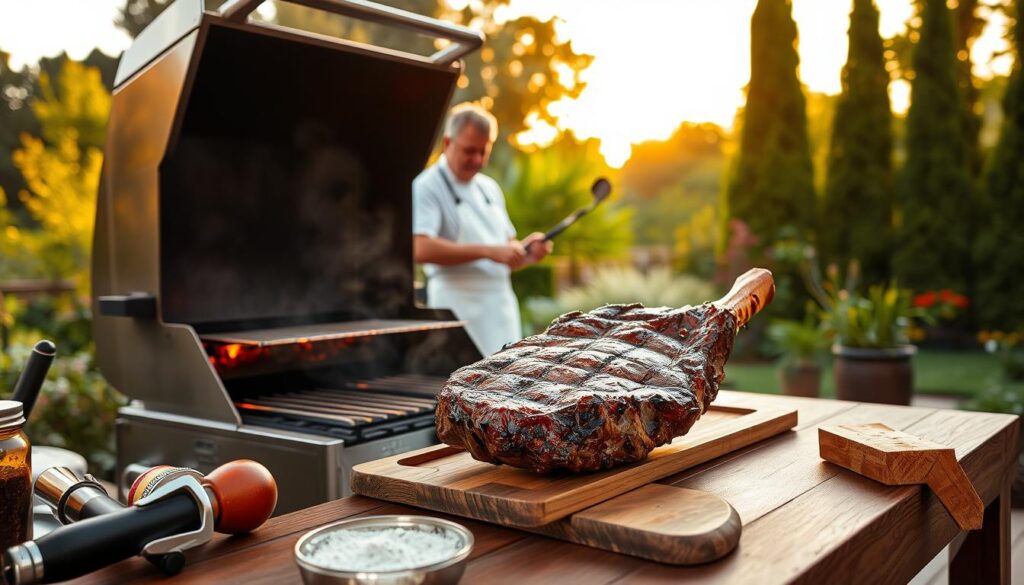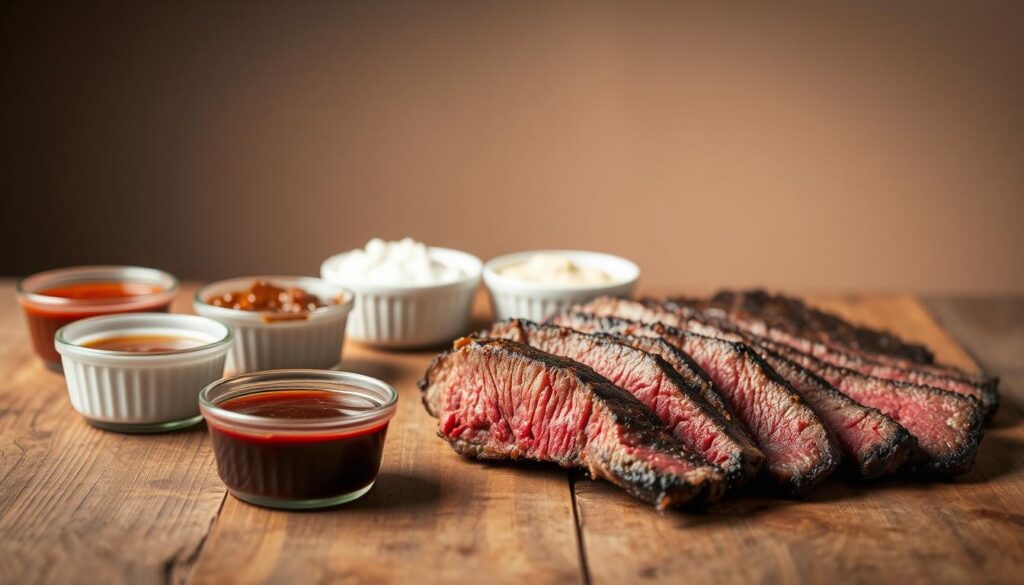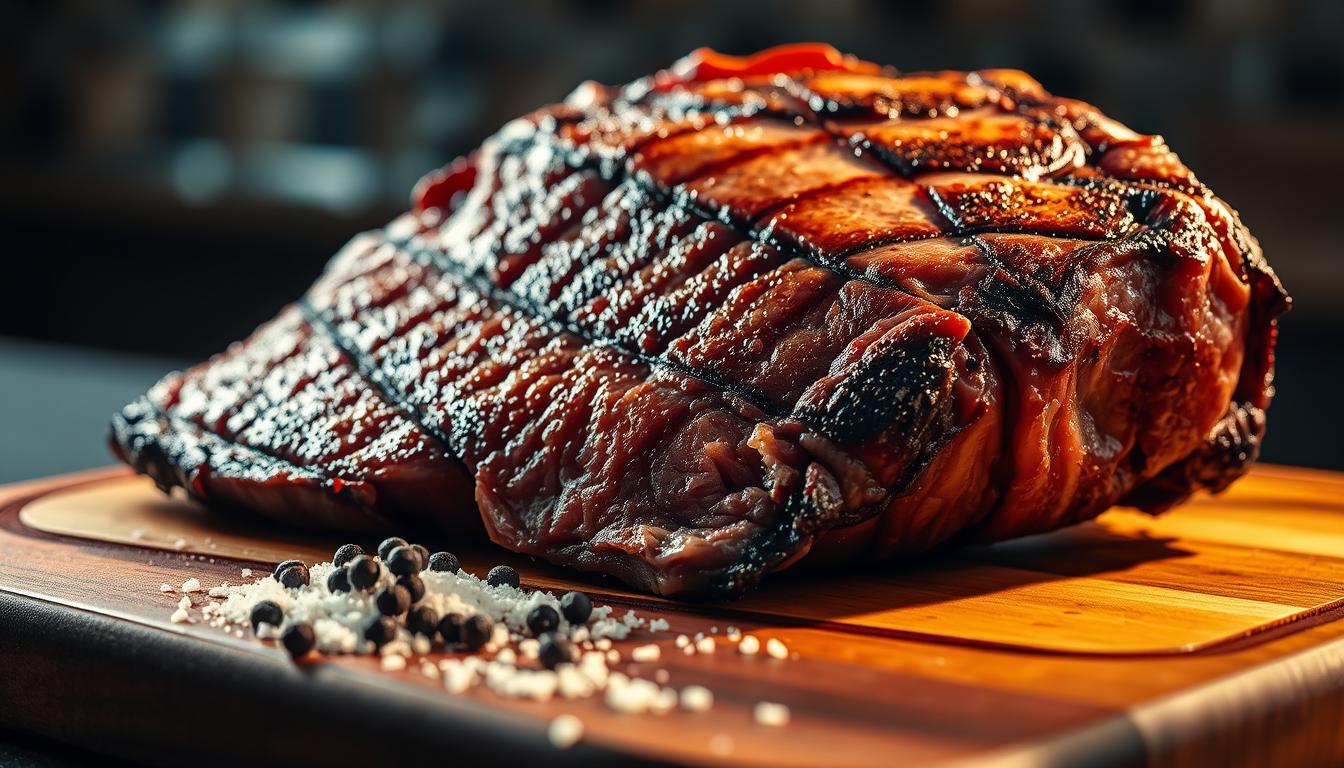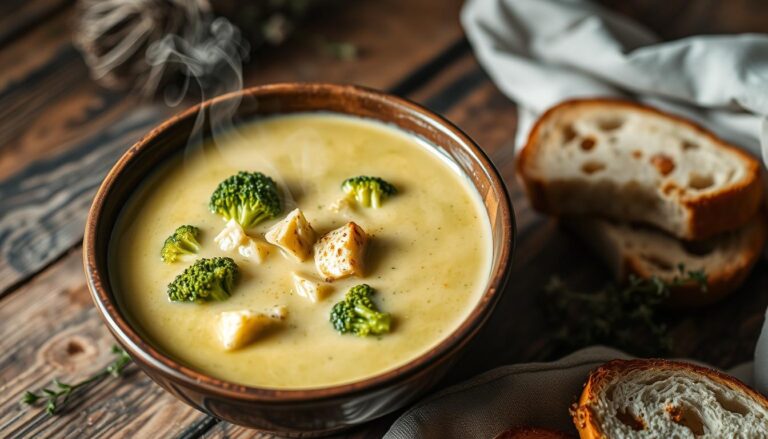Grilled Tomahawk Steak
Mastering the art of grilling a tomahawk steak can elevate your culinary skills and impress your dinner guests. This cut of meat, known for its rich flavor and tender texture, requires careful preparation to achieve perfection.
A perfectly grilled tomahawk steak is a true delight, with a crispy crust giving way to a juicy, pink interior. To achieve this, it’s essential to follow a reliable cooking guide that covers everything from preparation to serving.
Key Takeaways
- Understanding the characteristics of a tomahawk steak
- Preparation techniques for grilling
- Tips for achieving a perfect crust and interior
- Common mistakes to avoid when grilling
- Recommended cooking times and temperatures
What Is a Tomahawk Steak?
At its core, the tomahawk steak is a ribeye steak that has been cut in a way that leaves a significant portion of the rib bone intact, giving it a unique tomahawk-like appearance.
This distinctive cut of beef has gained popularity not only for its striking presentation but also for its rich flavor and tender texture. The tomahawk steak is essentially a type of ribeye steak, known for its marbling, which contributes to its taste and tenderness.
Origin and Characteristics
The tomahawk steak originates from the longissimus dorsi muscle of the cow, which is part of the rib section. This area is known for producing some of the most tender and flavorful cuts of beef due to its marbling.
The characteristics of a tomahawk steak include its generous size, typically weighing between 1.5 to 2 pounds, and its impressive presentation, with the long bone frenched to create a clean, handle-like appearance. The steak is known for its rich, beefy flavor and tender texture, making it a favorite among steak enthusiasts.
Why It’s Called the “Tomahawk”
The name “tomahawk” is derived from the steak’s resemblance to a tomahawk axe, with the long, frenched bone resembling the handle of the axe and the steak itself forming the blade.
This unique naming is not just a marketing gimmick; it reflects the steak’s distinctive appearance, which has become a hallmark of high-end dining experiences. The tomahawk steak’s name is a testament to its visually striking presentation, making it as much a feast for the eyes as it is for the palate.
Selecting the Perfect Tomahawk Steak
The journey to a perfectly grilled tomahawk steak begins with selecting the right cut. This involves understanding several key factors that contribute to the quality and flavor of the steak.
Understanding Beef Grades
Beef grades are a crucial factor in determining the quality of your tomahawk steak. In the United States, the USDA grading system is used, with Prime, Choice, and Select being the most common grades. Prime grade beef is of the highest quality, offering exceptional marbling, tenderness, and flavor. Choice grade is also popular, providing a good balance between quality and price. For a premium grilling experience, opting for Prime or high-quality Choice grade is recommended.
Marbling and Its Importance
Marbling refers to the intramuscular fat that is dispersed throughout the meat. It plays a significant role in the tenderness, juiciness, and flavor of the steak. A well-marbled tomahawk steak will be more tender and have a richer flavor profile. When selecting a tomahawk steak, look for cuts with visible marbling for the best grilling results.
Best Places to Purchase Quality Cuts
Finding the right place to buy your tomahawk steak is just as important as knowing what to look for. Here are some top recommendations:
| Source | Quality Expectation | Price Range |
|---|---|---|
| Local Butcher Shops | High | $25 – $45/lb |
| Specialty Meat Markets | High | $30 – $60/lb |
| High-End Grocery Stores | Medium to High | $20 – $35/lb |
| Online Meat Retailers | Variable | $18 – $70/lb (plus shipping) |
When purchasing, consider the source and the grade of the beef to ensure you’re getting a high-quality tomahawk steak.
Essential Equipment for Grilling Success
Grilling a tomahawk steak to perfection requires more than just skill; it demands the right equipment. Having the appropriate grilling equipment can make a significant difference in the outcome of your dish.
Choosing the Right Grill
Selecting the ideal grill is crucial for achieving grilling success. The type of grill you choose can significantly impact the flavor and texture of your tomahawk steak.
Gas vs. Charcoal vs. Wood
There are several types of grills available, including gas, charcoal, and wood-fired grills. Gas grills offer convenience and ease of use, while charcoal grills provide a traditional smoky flavor. Wood-fired grills add a unique, rich flavor to the steak.
Temperature Control Features
Regardless of the grill type, having precise temperature control is vital. This feature allows you to adjust the heat to achieve the perfect sear and cook.
| Grill Type | Temperature Control | Flavor Profile |
|---|---|---|
| Gas | Excellent | Mild |
| Charcoal | Good | Smoky |
| Wood-Fired | Fair | Rich, Smoky |
Must-Have Tools and Accessories
In addition to the grill, there are several grilling tools that are essential for a successful grilling experience. These include a meat thermometer, tongs, and a grill brush.
Preparing Your Tomahawk Steak Before Cooking
The journey to a perfectly grilled Tomahawk steak begins with proper preparation. Before you even think about firing up your grill, there are several crucial steps to take to ensure your steak is cooked to perfection.
Proper Thawing Techniques
If your Tomahawk steak is frozen, it’s essential to thaw it properly to preserve its texture and flavor. The best method is to thaw it in the refrigerator, allowing it to thaw slowly over several hours or overnight. This slow thawing process helps prevent bacterial growth and ensures even thawing.
Alternatively, you can use the cold water thawing method, submerging the steak in a leak-proof bag in cold water and changing the water every 30 minutes. Never thaw at room temperature, as this can lead to bacterial contamination.
Trimming and Frenching the Bone
Trimming excess fat from your Tomahawk steak can improve its overall appearance and help it cook more evenly. Use a sharp knife to carefully trim any excess fat, taking care not to cut into the meat. Frenching the bone involves scraping the bone clean of any meat and fat, creating a clean, elegant appearance.
This step not only enhances the visual appeal but also prevents any unwanted charring on the bone during grilling.
Dry Brining for Enhanced Flavor
Dry brining, or pre-salting, involves rubbing the steak with kosher salt and letting it sit in the refrigerator for several hours or overnight. This process enhances the steak’s natural flavors, improves its texture, and helps create a delicious crust when grilled.
To dry brine your Tomahawk steak, generously sprinkle both sides with kosher salt, then place it on a wire rack over a rimmed baking sheet and refrigerate. The dry brine will help to tenderize the steak and intensify its beefy flavor.
Seasoning Your Tomahawk Steak
The art of seasoning a tomahawk steak lies in balancing flavors that complement its rich, beefy taste. A good seasoning can elevate the dining experience, making the steak more enjoyable and memorable.
Seasoning is not just about adding salt and pepper; it’s about creating a flavor profile that enhances the natural taste of the steak. Various seasoning options can be used, ranging from simple to complex blends.
Classic Salt and Pepper Approach
The classic salt and pepper approach is a timeless method for seasoning a tomahawk steak. This simple yet effective technique allows the natural flavors of the steak to shine through while adding a touch of seasoning. To apply this method, generously sprinkle both sides of the steak with kosher salt and freshly ground black pepper.
Herb and Garlic Rubs
For those looking to add more complexity to their steak, herb and garlic rubs are an excellent option. By mixing minced garlic with chopped fresh herbs like thyme, rosemary, or parsley, and then rubbing the mixture onto the steak, you can create a flavorful crust that complements the steak’s natural taste.
As noted by culinary expert,
“A good rub can make all the difference in the flavor of your steak. It’s all about finding the right balance of herbs and spices.”
Global Spice Blends to Try
Exploring global spice blends can add an exciting twist to your tomahawk steak. For example, a blend of chili powder, cumin, and smoked paprika can give your steak a Mexican-inspired flavor, while a mix of soy sauce, ginger, and garlic can create an Asian-style steak.
Here’s a comparison of different seasoning options in a tabular format:
| Seasoning Type | Flavor Profile | Best For |
|---|---|---|
| Salt and Pepper | Simple, Enhances Natural Flavor | Purists who prefer the steak’s natural taste |
| Herb and Garlic Rubs | Complex, Savory | Those who enjoy a flavorful crust on their steak |
| Global Spice Blends | Varied, Adventurous | Adventurous eaters looking to try new flavors |
Experimenting with different seasoning options can help you find the perfect flavor for your tomahawk steak. Whether you prefer a classic approach or something more adventurous, the right seasoning can make your steak truly unforgettable.
How to Grill the Perfect Tomahawk Steak
The art of grilling a tomahawk steak lies in understanding the nuances of heat, timing, and preparation. To achieve a perfectly grilled tomahawk steak, one must consider several key factors, including the grilling technique, the temperature at which the steak is cooked, and the level of doneness desired.
The Reverse Sear Method
The reverse sear method is a highly effective technique for grilling a tomahawk steak. This method involves cooking the steak in a low-temperature environment first, followed by a high-heat sear.
Low and Slow Phase
During the low and slow phase, the steak is cooked at a lower temperature until it reaches a certain internal temperature, typically about 10-15 degrees below the desired final temperature. This step ensures that the steak cooks evenly throughout.
Benefits of Low and Slow Cooking:
- Even cooking throughout the steak
- Reduced risk of overcooking the exterior
- Enhanced tenderness
High-Heat Finishing
After the low and slow phase, the steak is then finished with a high-heat sear to create a crispy crust on the outside. This step adds texture and flavor to the steak.
Tips for achieving a perfect sear:
- Ensure the grill is preheated to a high temperature
- Pat the steak dry before searing to remove excess moisture
- Sear the steak for a short duration on each side
Direct Heat Grilling Technique
Direct heat grilling involves cooking the steak directly over the heat source. This method is ideal for achieving a nice char on the outside while cooking the inside to the desired level of doneness.

Temperature Guide for Every Doneness Level
Achieving the perfect doneness is crucial when grilling a tomahawk steak. The internal temperature of the steak determines its level of doneness.
| Doneness Level | Internal Temperature (°F) |
|---|---|
| Rare | 120-130 |
| Medium Rare | 130-135 |
| Medium | 140-145 |
| Medium Well | 150-155 |
| Well Done | 160+ |
Alternative Cooking Methods for Tomahawk Steaks
Exploring alternative cooking methods can reveal new flavors and textures in tomahawk steaks. While grilling is a classic approach, other techniques can offer consistency and unique culinary experiences.
As quoted by Chef Thomas Keller, “Cooking is not just about the food, it’s about the experience, and alternative methods can elevate that experience.”
“The beauty of cooking lies in its ability to bring people together, and experimenting with different techniques can make that moment even more special.”
Sous Vide and Sear Approach
The sous vide method involves sealing the steak in a bag and cooking it in a water bath at a precise temperature. This technique ensures consistent doneness throughout the steak. After sous vide cooking, a quick sear in a hot pan adds a desirable crust.
To achieve the best results, cook the tomahawk steak sous vide at 130°F – 135°F for 1-2 hours, followed by a sear in a preheated skillet. This method is praised for its precision and consistency.
Oven-to-Grill Method
The oven-to-grill method is another effective way to cook tomahawk steaks. Start by cooking the steak in the oven to achieve the desired level of doneness. Then, finish it on the grill to add a smoky flavor and a nice char.
This method allows for a gentle cooking process in the oven, followed by a high-heat finish on the grill, resulting in a tender and flavorful steak. Preheat the oven to 275°F and cook the steak until it reaches your desired doneness, then grill it for a few minutes on each side.
Mastering the Rest and Carve
Resting and carving are the unsung heroes of steak preparation, elevating your dish from good to great. As emphasized by culinary experts, “The quality of the steak is only as good as the care taken in its final presentation.” The process of resting and carving your tomahawk steak is crucial for achieving that perfect bite every time.
Why Resting Is Critical
Resting your tomahawk steak after grilling is a crucial step that allows the juices to redistribute throughout the meat. This process ensures that each bite is tender and full of flavor. As Thomas Keller, a renowned chef, once said, “Resting is not just a pause; it’s an essential step that makes the steak more succulent.” When you rest your steak, you’re giving the fibers time to relax, making the meat more tender and enjoyable.
Proper Slicing Techniques
Once your steak has rested, it’s time to carve. Proper slicing techniques are vital for maximizing tenderness. Always slice against the grain, using a sharp knife to prevent tearing the meat. As
“A sharp knife is a chef’s best friend,”
a saying that holds true for any steak enthusiast. Slicing against the grain not only improves texture but also enhances the overall dining experience.
Elevating Your Steak with Sauces and Butters
To truly elevate your grilled tomahawk steak, consider the impact of well-crafted sauces and compound butters. These additions can enhance the natural flavors of the steak, providing a more complex and satisfying dining experience.

Classic Steak Sauce Recipes
A good steak sauce can make all the difference. Classic recipes often feature a balance of tangy and savory flavors. For instance, a Béarnaise sauce, with its rich egg yolks, butter, and herbs, is a timeless choice that pairs beautifully with the bold flavor of a tomahawk steak.
Another popular option is the peppercorn sauce, which combines the subtle kick of peppercorns with a creamy base, complementing the steak’s charred exterior and tender interior.
Gourmet Compound Butters
Compound butters offer a versatile and flavorful way to enhance your steak. By mixing softened butter with various ingredients, you can create a range of delicious accompaniments.
Herb Butter Variations
Herb butters, infused with fresh or dried herbs like parsley, chives, or thyme, add a bright, aromatic flavor to your steak. Simply mix chopped herbs into softened butter, shape into a log, and chill until firm.
Blue Cheese and Other Flavored Butters
For a bolder flavor, consider making a blue cheese butter by blending crumbled blue cheese with softened butter. Other options include garlic butter, made by mixing minced garlic into butter, or a spicy butter, infused with chili flakes or hot sauce.
As Julia Child once said, “The only time to eat diet food is while you’re waiting for the steak to cook.” This quote encapsulates the indulgent nature of enjoying a perfectly grilled steak with rich, flavorful sauces and butters.
Perfect Side Dishes for Your Tomahawk Feast
Complementing your grilled tomahawk steak with the right side dishes can elevate your dining experience to new heights. A well-chosen accompaniment not only enhances the flavors of the steak but also adds variety and texture to the meal.
Vegetable Pairings
Vegetables are a natural pairing with steak, offering a refreshing contrast to the rich flavors of the tomahawk. Consider grilling or roasting vegetables like asparagus, Brussels sprouts, or bell peppers to bring out their natural sweetness. A simple seasoning with salt, pepper, and a drizzle of olive oil can make these vegetables shine. For a more robust flavor, try tossing them with garlic and herbs before cooking.
Potato and Starch Accompaniments
Potatoes and other starches are classic steakhouse accompaniments that pair perfectly with the hearty flavor of a tomahawk steak. Twice-baked potatoes or garlic mashed potatoes are comforting choices, while grilled potato wedges or potato gratin offer a crispy, flavorful alternative. Other starches like creamy polenta or roasted sweet potatoes can also complement the steak nicely.
Wine and Beverage Recommendations
No steak dinner is complete without a suitable beverage to accompany it. For a tomahawk steak, a full-bodied red wine such as Cabernet Sauvignon or Syrah/Shiraz is an excellent choice, as their robust flavors can stand up to the steak’s richness. For those who prefer a non-wine option, a craft beer like a stout or IPA can also pair nicely. Alternatively, a classic whiskey on the rocks or a Manhattan cocktail can add a sophisticated touch to your meal.
Troubleshooting Common Grilling Issues
Grilling a tomahawk steak to perfection is an art that involves troubleshooting common grilling issues. Even with careful preparation, problems like flare-ups and uneven cooking can occur, affecting the quality of your steak.
Dealing with Flare-Ups
Flare-ups are sudden bursts of flame that can char your steak unevenly. To manage flare-ups, keep a spray bottle of water handy to dampen the flames if they get too high. Trimming excess fat from the steak before grilling can also help minimize flare-ups. Additionally, adjusting the grill’s heat or temporarily moving the steak to a cooler part of the grill can prevent burning.
Fixing Uneven Cooking
Uneven cooking can result from various factors, including inconsistent grill temperature or steak thickness. To achieve even cooking, ensure your grill is preheated to a consistent temperature. Using the reverse sear method can also help cook the steak evenly, as it involves cooking the steak at a lower temperature before searing it at high heat. Monitoring the steak’s internal temperature with a meat thermometer is crucial for achieving the desired doneness.
Conclusion
Grilling a tomahawk steak is an art that requires attention to detail, the right techniques, and a bit of practice. Throughout this guide, we’ve explored the key elements to help you achieve a perfectly cooked tomahawk steak. From understanding the characteristics of a tomahawk steak to selecting the right equipment and mastering various cooking methods, you’re now well-equipped to tackle this culinary challenge.
A successful grilling conclusion relies on practice, patience, and persistence. As you continue to hone your skills, you’ll develop a keen sense of how to balance flavors, temperatures, and textures to create a truly exceptional dining experience. The tomahawk steak summary highlights the importance of proper preparation, seasoning, and cooking techniques in achieving a mouth-watering result.
With these skills under your belt, you’re ready to impress your friends and family with a show-stopping tomahawk steak. So, fire up your grill, and get ready to savor the rich flavors and tender texture of a perfectly grilled tomahawk steak.
FAQ
What is a tomahawk steak?
A tomahawk steak is a cut of beef that is essentially a ribeye steak with the bone left intact, characterized by its distinctive “tomahawk” shape.
How do I choose the right tomahawk steak?
When selecting a tomahawk steak, consider factors such as beef grade, marbling, and the quality of the cut, opting for a reputable butcher or high-end grocery store.
What is the best way to grill a tomahawk steak?
The reverse sear method is a popular technique for grilling tomahawk steaks, involving low and slow cooking followed by a high-heat finish to achieve a perfectly cooked crust.
Can I cook a tomahawk steak using alternative methods?
Yes, alternatives to grilling include sous vide and oven-to-grill methods, offering flexibility and variety in cooking tomahawk steaks to achieve a delicious result.
Why is resting important after cooking a tomahawk steak?
Resting allows the juices to redistribute, ensuring the steak remains tender and flavorful when sliced, making it a crucial step in the cooking process.
How do I slice a tomahawk steak correctly?
To slice a tomahawk steak, cut against the grain using a sharp knife, taking care to slice evenly and at the correct angle to maximize tenderness.
What are some recommended side dishes for a tomahawk steak?
Popular side dishes include roasted or grilled vegetables, potatoes, and starch accompaniments, as well as wine and other beverage recommendations to complement the meal.
How can I enhance the flavor of my tomahawk steak?
Consider using sauces, such as classic steak sauce recipes, or compound butters, like herb or blue cheese butter, to add an extra layer of flavor to your tomahawk steak.
What are some common grilling issues and how can I troubleshoot them?
Common issues include flare-ups and uneven cooking, which can be addressed by adjusting grill temperature, using a thermometer, and employing techniques like rotating the steak to achieve even cooking.
What is dry brining, and how does it enhance the flavor of a tomahawk steak?
Dry brining involves rubbing the steak with salt and other seasonings to enhance flavor and texture, resulting in a more complex and satisfying taste experience.
How do I store and handle a tomahawk steak before cooking?
Proper handling includes storing the steak in the refrigerator at a consistent temperature, thawing it correctly if frozen, and trimming or Frenching the bone as needed before cooking.







